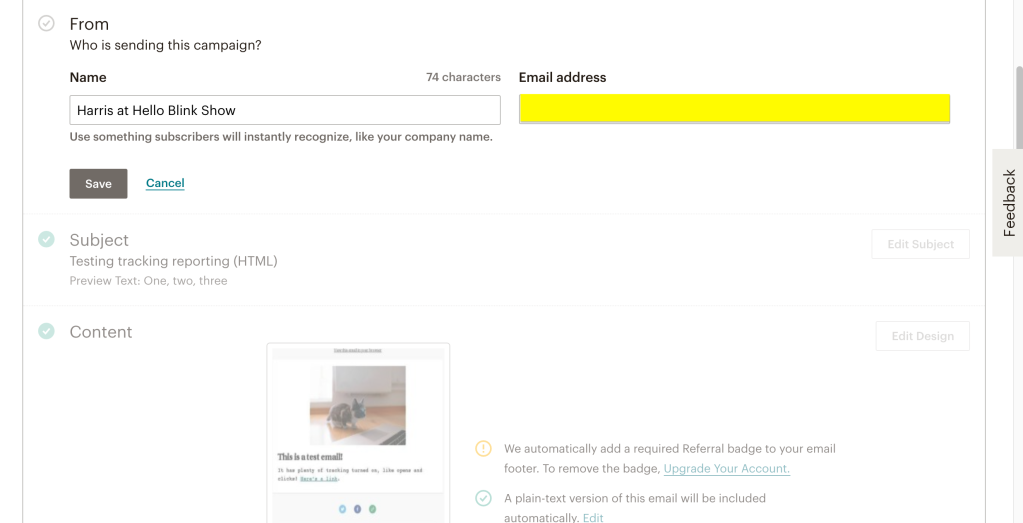I officially got my invite for HEY, the new email platform by Basecamp. I’ve been following this project closely and am excited to test one specific feature that I’ve been curious about: spy trackers (or tracker reporting).
I’m going to approach this both as a recipient of emails and also with my marketing hat on as a sender of email marketing campaigns.
HEY versus Trackers
One of the most promoted features of HEY is their stance on trackers. (Read in-depth about Spy Trackers in HEY here.) If you’re not familiar with Spy Trackers, the short version is that sales and marketing technology companies conduct surveillance on email recipients. Most of the time this is done through loading invisible pixels in emails.
This kind of reminds me of how the initial versions of Windows Subsystem for Linux loaded the Linux kernel as a Driver. (It may still do this, I haven’t been following closely.) Either way, it’s like driving a truck through a pin hole in terms of getting way more through a technology than initially intended.
As a recipient and someone who chooses HEY, obviously I like this feature. As a sender, there’s obviously going to be concern. And if there is a critical mass of people moving in the direction of tracker blocking, it is going to cause chaos for automated sales and marketing campaigns. But that’s a post for another day.
Why Care?
Let’s take a step into the seat of the professional marketer or small business owner who’s sending email campaigns. (Campaigns are the conventional term, with an interesting etymology.)
There are a few reasons why you might not want to be flagged by HEY as using tracking in your emails, maybe you:
- Have privacy conscious consumers
- Sell a product that may require discretion
- Worry about private surveillance in general
- Don’t want to get called out online for tracking
So, how do you test your emails?
Testing with MailChimp
I’m going to do this manually using MailChimp. I have a few different email addresses and a few different MailChimp accounts. It’s a large and successful email marketing provider in the USA so it should be a helpful starting point.
I looked to see if there was an easy way to disable tracking in Settings at the account level in MailChimp but I couldn’t find it. This appears to be controlled on a per-campaign basis which makes this a manual process. It’d be nice if they offered a universal way to toggle off tracking. Or if they already do, please let me know.
Testing Plain-text and No Tracking
For now, let’s start with verifying that the Spy Tracking feature works. If we disable all tracking, what does it look like in HEY? MailChimp let’s you send Plain-text emails, they don’t load any images or any tracking.

The only way to track would be by checking the box to allow MailChimp to append a custom URL onto the end of the email.

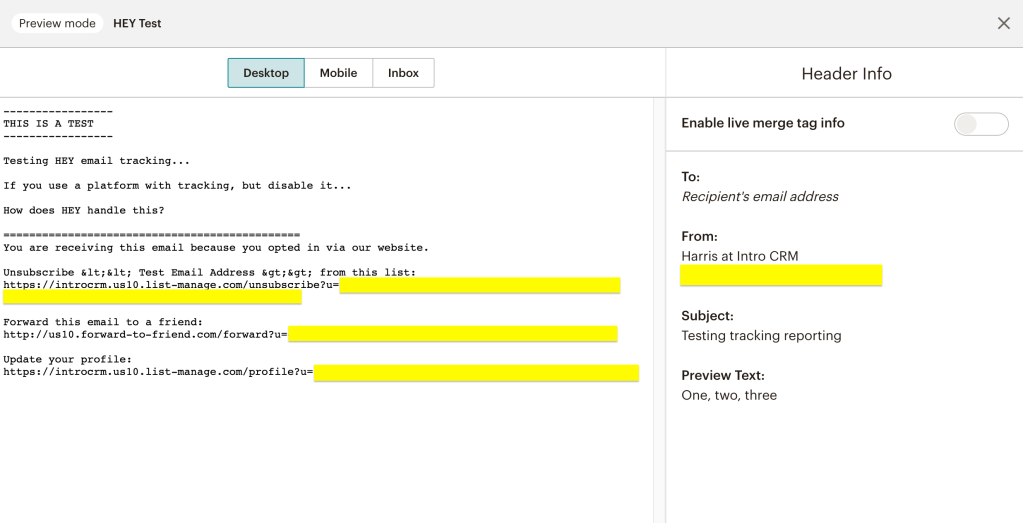
Wearing my marketer hat here and for the sake of expediency, I’m going to dispatch these as test emails, which I can send one at a time to single addresses. There are a few interesting things to point out below, some of which you might notice if you’re familiar with MailChimp.
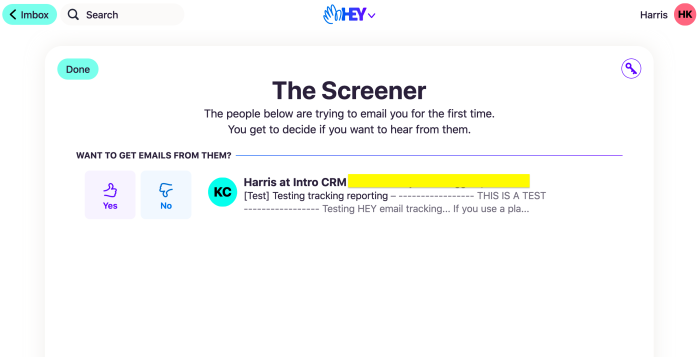
- This is the first email from this recipient, so it worked and was caught by The Screener.
- FYI when you send test emails in MailChimp that they append [TEST] onto the beginning
- In The Screener, HEY cuts out the “Preview” text that you enter in MailChimp’s campaign editor, meaning it goes right to the body text
Out of the box, any MailChimp sender can meet the standards that Basecamp have set for the email experience in 2020. But this email is hard to look at and they block the trackers so you can get all those nice images. Let’s try sending a regular HTML email with tracking.
Testing HTML and Tracking
Let’s try a regular email with all the standard tracking bells and whistles included as standard. When you draft a typical campaign in MailChimp, these are enabled by default.

Next, we draft up a simple email, but I wanted to make sure to include an image. Included photo by Sereja Ris on Unsplash.
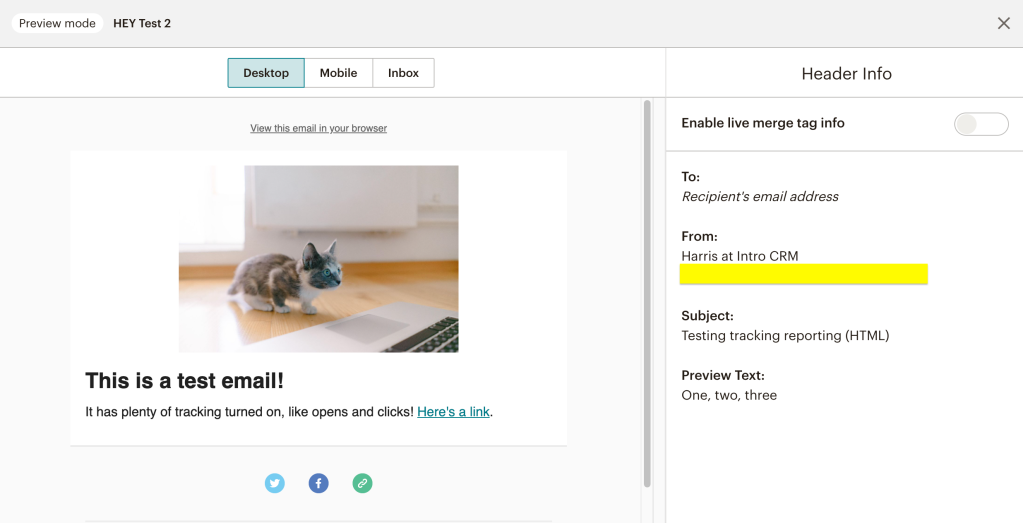
Here’s where things get interesting.
Slipping Past the Screener
Let’s get back to HEY, remember The Screener? It doesn’t just screen all individual emails. Here’s what it does do:
The Screener
HEY
The people below are trying to email you for the first time.
You get to decide if you want to hear from them.
The first time—that’s key! So, I sent the new HTML email with tracking and The Screener worked. Using the same email address, it bundled the two emails and I can’t see the second email. I like this approach.
You could make the case that HEY could have some indicator of how many extra emails have been sent. Common with things like drip campaigns. But I think that would just increase the feeling of urgency that the uninvited sender is trying to impose on you as the recipient.

MailChimp offers a way to configure the sender. So I wanted to test, if I change the sender, will that get through/past The Screener?
First I tried changing the email that the campaign is sending from, while maintaining the same sender name. Next, I tried changing the name that the campaign is sending from, while maintaining the same email address.
In both cases, it seems The Screener detected that this was the same sender. Merely re-configuring one “From” field in MailChimp was not fooling HEY.
Lastly, I tried changing both the name and the email address that the campaign is sending from. Changing both fields, we were able to slip past The Screener.
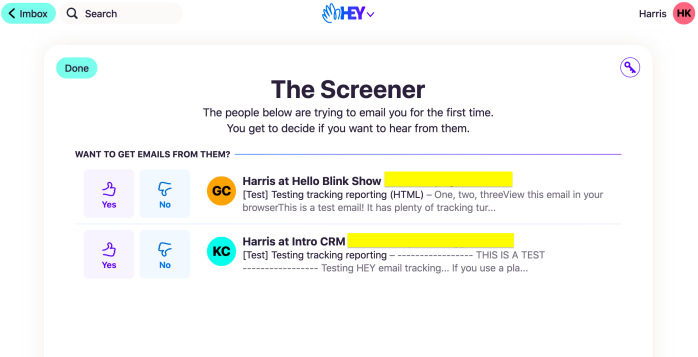
Another thing to note is in the image above is that the Preview text from MailChimp does come through in the HTML email.
The point of this exercise is to just understand how HEY works. Whether you’re a HEY customer, or a marketer.
Is The Screener Asleep?
On the surface, I’m not sure if getting past The Screener as we did is necessarily a problem.
First if they wanted to, HEY might be able to flag this issue by pulling the MailChimp URL for the account (accessible through the links under “Update Your Preferences” and “Unsubscribe from this List”). In those cases, MailChimp uses the account name at the beginning of the URL like this: https://example.us10.list-manage.com/profile?u
HEY could then automatically bundle the emails as from the same sender, or HEY could at least flag the seeming similarity between the two senders. But just because an account is the same, it might be coming from different parts of a company (say one email comes from Marketing and another from Billing). Maybe it’s best to leave that distinction and approval/disapproval to the HEY customer.
There is no algorithm determining what you can or cannot see. The HEY customer will get a chance to filter through these emails and decide what lands in the Imbox. If a marketer fools The Screener once, the recipient can block both emails and both senders.
Practically speaking though, marketers face trade-offs if they are constantly changing their Sender/”From” fields. It creates confusion among the people interested in what they have to say. MailChimp themselves provide the following guidance when filling out that field:
Use something subscribers will instantly recognize, like your company name.
MailChimp
It seems unlikely Marketers will be doing this workaround often. And unscrupulous spammers will get caught in HEY’s Spam filters.
In short, no, I don’t believe The Screener is Asleep.
N.b. How blocking trackers affects deliverability statistics and whether mailing list recipients are considered active or not is a separate conversation for another post.
Landing in the Imbox
Pardon that walkabout, let’s get back to it. Let’s approve and green light the emails, allowing them into our Imbox. Turning to the Imbox, you can see the emails all made it through.

Here’s where my test fell short. Test emails, while you may include tracking when you’re setting them up, apparently don’t have active tracking in when they’re sent. Here are both emails, opened in HEY.

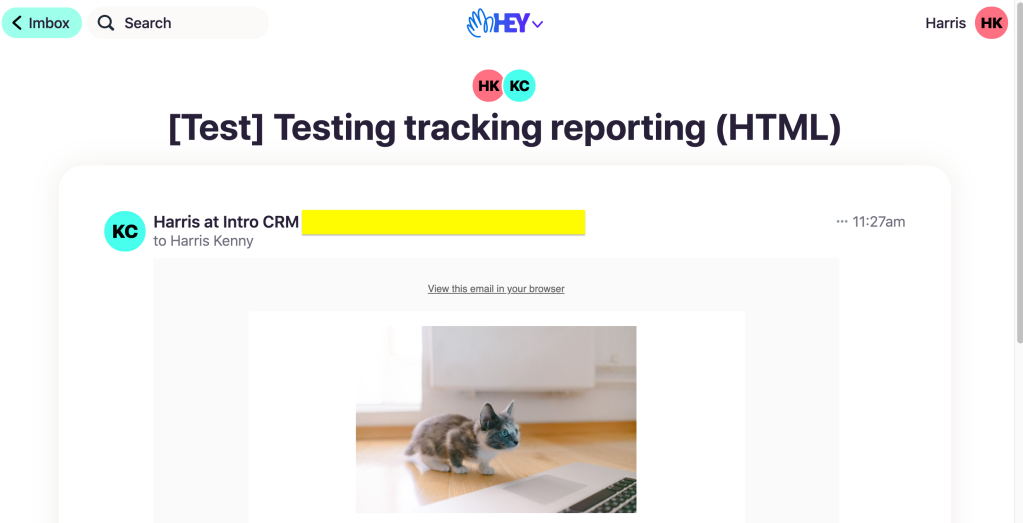
So there’s a little quirk. If you are wanting to test how your email is delivering to end users you’ll want to send it as a proper campaign and ensure that all tracking is indeed delivering tracking.
Short cuts make long delays.
J.R.R. Tolkien
Sending Real Campaigns
In order to send to targeted contacts, I’m going to use the tagging feature in MailChimp to deliver to the specific recipients I want for this experiment, with tracking enabled. We’ve also sorted through how The Screener works, so we don’t have to re-test that either.



Lastly, let’s try doing a full HTML campaign but with tracking disabled. If this works, it means that marketers can send nice looking emails without the tracking. All that’s required? Checking on a per-campaign basis to ensure tracking is not on.

Interesting, MailChimp seems actively concerned about the fact that we’re not using tracking! Check out these warning icons.

Alright let’s send this final email…
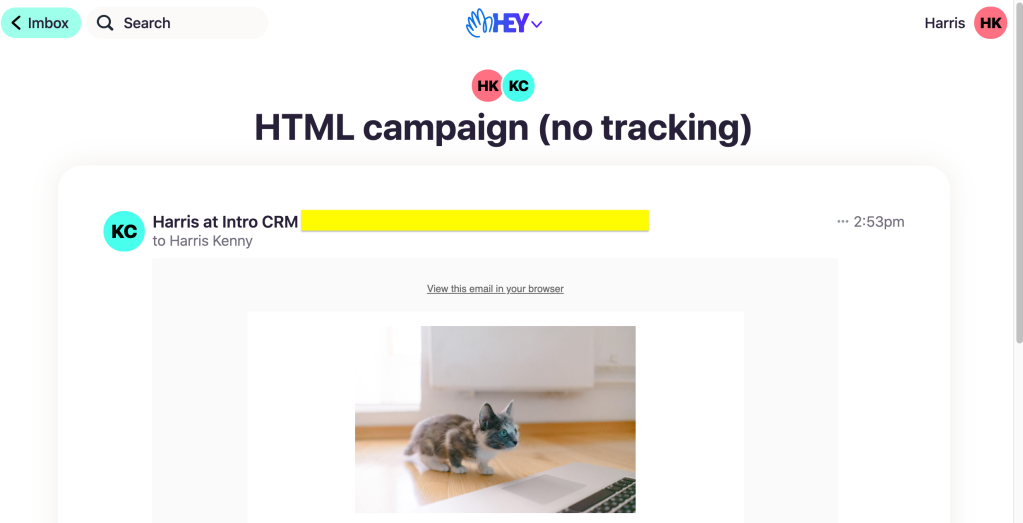
Yay! Our email has been received and we aren’t seeing a Spy Tracker warning from HEY. While it took some extra work, it seems like we’re in a good spot. Except for one thing…

It’s funny because when I’m in the Campaign Builder, I didn’t type out that massive link. Here’s what it looks like instead, with a simple and clean URL.

In HEY, I clicked the link to test it out and it did work fine as is to be expected. I landed on the right website. Let’s go back into reporting in MailChimp to see what’s going on here.


MailChimp is inserting their own URL redirect to the plain URL that the marketer uses in Campaign Builder. MailChimp is not sharing reporting on that activity back to the marketer who is sending out campaigns using the platform. But MailChimp is aware of what’s being clicked.
Can These Platforms Coexist?
Without going deeper into examining the source code, it appears that yes these two platforms can coexist… For now. Marketers can send good looking HTML emails, without tracking, and they can avoid the Spy Tracker warning in HEY. MailChimp does not make this easy, however.
These platforms are at odds on a fundamental level over our relationship with technology. If HEY itself as a platform gains traction and other platforms successfully emulate the features that the team at Basecamp has built, it’s only a matter of time before this starts getting really interesting.
There seems to be massive demand for what they’re building with HEY. The team at Basecamp has built popular, intuitive SaaS apps with millions of users. And HEY will be rolling out to businesses in the future.
In the meantime, I’m looking forward to enjoying email again.

